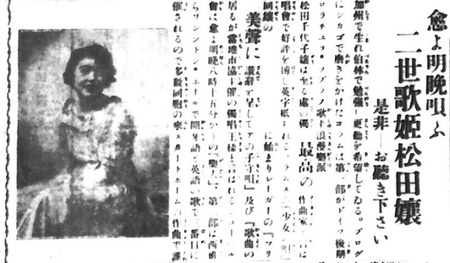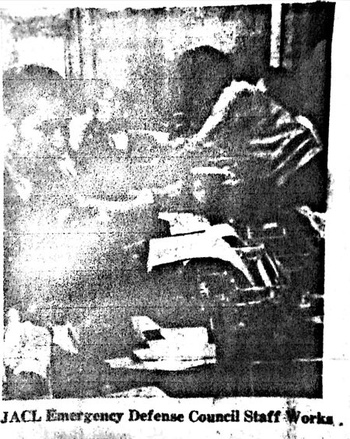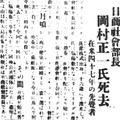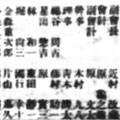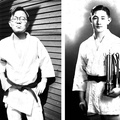Establishment of Mothers’ Committee
“JACL’s Mothers’ Committee and Its First Meeting” (March 16, 1939 issue)
For the purpose of promoting mutual understanding and cooperation between mothers and daughters, the JACL has decided to form Mothers’ Committee, and its first meeting will be held on the coming 20th. They are expecting many mothers across all women’s organizations to attend, as they plan to host discussion sessions in a not-too-distant future for them to exchange opinions on matters such as family issues and discipline of Nisei girls. Sakamoto comments:
“Apparently there are a lot of housewives who are not part of any women’s organizations, so with the JACL as the initiator we hope to achieve mother-daughter cooperation by forming a unified mothers’ committee.”
Sumiyoshi Arima commented on this Mothers’ Committee in his column “Hokubei Shunjyu” as below.
“The JACL and Mothers’ Committee” by Ichiro Hanazono (May 9, 1939 issue)
So I heard that the JACL took the initiative and formed Mothers’ Committee. Their aim is to achieve mutual understanding and cooperation between mothers and daughters, and they will eventually get to have discussions to exchange opinions and conduct research on family problems and discipline of Nisei girls. All of these have been proposed by the JACL, and I must say that they are some of the best moves the JACL has made recently. . . .
The community of our peers in America is a unique one where its members are defined as Japanese racially but are heavily influenced by American ideology, customs and trends socially. In particular, the birth and growth of Nisei will further make this social life and ideology complicated. They are Japanese and American, and they speak English and learn Japanese. At home, they naturally inherit old Japanese customs, yet it becomes impossible to avoid American customs and ideology as they spend more time in the country. . . .
Our peer women are shouldering a burden with unusual responsibilities and missions simply because they are mothers of American citizens. I’m one of the people who are sincerely happy to see the birth of Mothers’ Committee made for understanding and cooperation of those mothers and their children.
Hosting Performance Shows
The JACL hosted performance shows and encouraged many to participate, in an effort to make connections with the existing Seattle Japanese community and to raise funding at the same time.
“JACL Performance Show” (October 19, 1935 issue)
The JACL performance show will take place at the Japan Hall. . . . The admission fee is 35 cents for adults and 20 cents for children, and their plan is to allocate this revenue to the expense of the convention which will be held next year here.
“A Fun Night Hosted by the JACL” (April 27, 1939 issue)
The Community Night sponsored by the JACL will be held tomorrow. The program is as follows: greetings by guests, Consul Sato, Genji Mihara, Takeo Nogaki, dance, piano, violin and cello performances, solo singing performance, etc. (the names of all performers are listed)
“JACL Performance Show” (November 1, 1939 issue)
The JACL’s fund raising performance show will start spectacularly at 7 p.m. at the Japan Hall on the coming 4th and 5th. Program: comedy performance in English, the Kusatsu-bushi (the song of Kusatsu) dance, solo singing, violin performance, tap dance, dance by Sansei, solo singing, reading, Chikuzen-biwa (a string instrument) performance, accordion performance, shakuhachi and shamisen ensemble, the Yasugi-bushi dance, “Return of Father” by Kan Kikuchi, the Spanish dance, violin performance and comedy performance (the names of all performers above are listed)
“Nisei Singer Lady Matsuda” (December 5, 1939 issue)
Born in California, the coloratura soprano singer Chiyoko Matsuda studied in Berlin and further honed her singing in Chicago. Her solo concerts have been well liked in many places, and English papers, too, have been praising her beautiful voice. As her Seattle JACL-sponsored solo concert will be held tomorrow evening at the Washington Hall, we expect a big number of peers to come.
The JACL During Wartime
The JACL had made their political activities take root by the time the Japan-U.S. war broke out, and they had achieved a number of improvements in the rights of Nikkei citizens. Once the war began, many articles were published to report the JACL’s best effort to protect the Nikkei community in Seattle.
“The Splendid Patriotic Day of Nikkei Citizens” (January 9, 1942 issue)
The Patriotic Day was hosted by Spokane Nikkei Citizens Club, and it turned out to be quite an event on a scale we haven’t seen recently, with over 200 participants of both Issei and Nisei. They invited city mayor Sadlin, US assistant attorney Ellison and two news writers from both English papers in Spokane City.
“Heart-Felt Response to Oath of Loyalty to the U.S.” (January 13, 1942 issue)
The Convention of the Strengthening of Americanism hosted by the JACL Emergency Defense Council took place on December 22 last year, and it was attended by 2,000 people making the event the biggest kind since the start of the community. At the convention, a resolution expressing the loyalty to the U.S. was adopted, with approximately 1,300 signatures, and it was immediately sent to President Roosevelt; in response, a letter of gratitude signed by Assistant Director of Foreign Service Institute Harold Hoskins was delivered on January 12 last year, addressed to chairperson Sakamoto of the JACL Emergency Defense Council.
“Portland JACL Hosts Convention of the Strengthening of Americanism” (January 21 and 24, 1942 issues)
Under the current state of emergency, in order to provide an opportunity not only for Nisei but also for Issei to pledge their loyalty to the U.S., the Portland JACL will host the Convention of the Strengthening of Americanism on the coming 23rd at the auditorium hall of Shattuck School. To this convention in particular, well-known white leaders – including city mayor Relay, police chief Niles, Secretary Doyle at Red Cross and editor Dana from Oregon Journal to name a few – will come and make their speeches. . . .
With an audience of 600, the convention was highly successful to the level we haven’t seen very recently, and the white leaders on the guest list all delivered their speeches with full sympathy for Nisei and their Issei parents, emphasizing that together they need to move forward at any cost for the nation to be united. At this convention, it was unanimously decided that they would telegraph President a resolution of the pledge of loyalty to the U.S., signed by all participants.
“Chief Secretary Masaoka from JACL to Visit Seattle Soon” (January 28, 1942 issue)
Masaoka, who as chief secretary of the JACL puts all his efforts into working for the Japanese community in any emergency situations, has left San Francisco on the 26th and began his journey northward. He will first have a talk with government authorities in Sacramento, go to Portland and come to our area to discuss various issues with the chair of the northwestern branch of JACL Tam Iseri, Yoshinori Sakamoto and others.
“JACL Photos in The Times” (January 31, 1942 issue)
The Seattle Times today published full-photographic pages of the painstaking work of the JACL staff members who all day devote their life to solving issues and preventing them in the Japanese community that has been ever becoming complicated since the outbreak of the war, and the life of Nisei under the wartime regime.
“Election of JACL Council Board Members” (February 2, 1942 issue)
At the election of council board members for the northwestern branch of JACL which took place yesterday morning, Tam Iseri was unanimously reelected chairperson, and the lawyer Seiya Arai and George Yasumura were elected chief secretary and accountant, respectively. Chief secretary of the JACL Masaoka has been in Seattle by the way, and a welcome dinner party is planned tonight at the Gyokkoken restaurant.
There was an article quoting Sakamoto, published immediately after President Roosevelt’s Executive Order 9066 was issued on February 19, 1942, which “granted the secretary of war and his commanders the power to prescribe military areas.”
An English paper reports the comment of chairperson Sakamoto of the JACL Defense Council given on the 24th.
“Chairperson Sakamoto of the Defense Council Says Communal Relocation Is Rather Preferred” (February 25, 1942 issue)
“We want to stay here and fight for the country with other Americans, but at the same time we are determined to follow the order if it requires us to move out. However in such circumstances, I believe that it is best to relocate as a community in order to avoid difficulties in our life afterwards. If so, we can work as a group and do anything – cultivate a field or build a factory – wherever we go. If and when relocation becomes a reality, we the Japanese will ask for someone competent enough to rightly protect all the property that we will leave behind.”
“A Hearing To Be Held Tomorrow on the Issue of Eviction – Chairperson Sakamoto of the Defense Council Will Attend” (February 27, 1942 issue)
During the war, Yoshinori Sakamoto served as chairperson of the JACL Defense Council and attended the hearing on the eviction issue to protect the Japanese residing in Seattle as one of the nine leaders and attestants, alongside Washington governor Langlie, Seattle mayor Millikin, and others.
On the front page of the March 12, 1942 issue of The North American Times, which became its last issue, there was a photo of the staff members of the JACL Emergency Defense Council sweating at work in their office. It captured a scene in which the staff members were talking to people in related organizations, trying to do everything they could to save Nikkei people in Seattle who were under threat of eviction.
In the next chapter, I will introduce articles about the activities of the Kibei (returning to the U.S.) JACL which was formed by Kibei Nisei who returned to Japan at a young age and later re-entered America.
References
Kojiro Takeuchi, Beikoku Seihokubu Nihon Imin-shi (History of Japanese Immigrants in the Northwestern United States), Taihoku Nippo-sha, 1929.
Consulate-General of Japan in Seattle, History of Nikkei in Washington, Consulate-General of Japan in Seattle, 2000.
Edited by Zaibei nihonjin-kai jiseki hozonbu, History of the Japanese in the U.S., Nihonjin-kai in the U.S., 1940.
*The English version of this series is a collaboration between Discover Nikkei and The North American Post, Seattle’s bilingual community newspaper. This article was originally publishd in Japanese on July 3, 2022 in The North American Post.
© 2022 Ikuo Shinmasu


